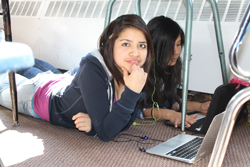Connecting America’s Schools to Next-Generation Broadband
The White House recently set an ambitious goal to connect 99 percent of American students to ultra-fast broadband within five years. President Obama’s ConnectED initiative would bring Internet speeds of at least 100 megabits per second and high-speed wireless to K-12 schools across the nation.
At NTIA, we are already making these types of connections a reality in K-12 schools through our Broadband Technology Opportunities Program, which has invested about $4 billion in roughly 230 projects nationwide to expand broadband availability and use. Of our 116 network infrastructure projects, about 75 percent are linking or supplying additional bandwidth to schools. Overall, roughly 10,000 schools in 44 states are being connected or upgraded, and almost 70 percent are getting access to speeds of at least 100 megabits.
Thanks to our grant program, teachers, students and parents are witnessing how technology can transform education, expand student horizons and create new opportunities for those living in even the most remote corners of the country.
A high-speed Internet connection can let students take online courses and access cutting-edge research at universities across the country. It can bring Advanced Placement classes and foreign language programs to small rural schools with limited resources. And it can help teachers customize lessons for students at different learning levels by leveraging all sorts of online curriculum materials.
But all this requires bandwidth – enough bandwidth to handle online video and other applications that rely on high-speed connections to the Net, and enough bandwidth to pipe this content into multiple schools and classrooms with dozens of computers and tablets logged on at once. That’s why the State Educational Technology Directors Association projects schools will need Internet connections of at least 100 megabits per second for every 1,000 students and staff by the 2014-15 school year, and 1 gigabit per second by 2017-18.
The projects funded through NTIA’s broadband grants program are already delivering these speeds to schools across the country. One state leading the charge is North Carolina.
MCNC, a non-profit broadband provider that operates the North Carolina Research and Education Network (NCREN), has leveraged NTIA funding to significantly expand and fortify its statewide fiber-optic network – ensuring it can scale to meet the ballooning bandwidth needs of North Carolina schools in the years ahead.
MCNC supplies high-capacity Internet backhaul connections for education and other anchor institutions across the state - including North Carolina’s 115 K-12 school districts, with nearly 2,500 schools. NCREN serves as a “middle-mile” bridge that links districts to each other, to advanced research networks such as Internet2 and to the Internet itself.
In recent years, network utilization by these 115 districts has skyrocketed - from a gigabit in 2009 to 35 gigabits during peak hours today. NTIA’s broadband grants program has enabled MCNC to keep up, and prepare for more growth to come.
MCNC has used its federal investment to upgrade 800 miles of existing fiber and add 1,800 miles of new fiber across its network – giving school districts access to speeds of 100 megabits or faster. Our program is also funding direct fiber connections to NCREN for districts in many rural areas where providing these “last-mile” connections would otherwise not make business sense.
This new bandwidth is changing the way teachers teach and students learn in North Carolina.
The Avery County public school system, with nine schools and 2,250 students in the rural northwest corner of the state, now has 250 megabits coming into the district. This capacity has enabled Avery to equip all sixth through 12th graders with MacBooks that students can take home at night, and all kindergarteners through fifth graders with iPads.
The Avery County public school system has assigned every child a laptop or a tablet.
With one-to-one computing, individualized Web-based projects are replacing teacher lectures. Online instructional resources are replacing textbooks. And teachers are using cloud-based tools to create virtual classroom portals where they can post lesson materials, make assignments and communicate with parents.
Rutherford County Schools, with 19 schools and 8,800 students in southwest North Carolina, is making similar use of technology with up to 500 megabits of bandwidth. It, too, has given laptops to every teacher and every sixth through 12th grader.
By supplying every student with a computer, Rutherford has been able to migrate from paper and pencil drills to more engaging, interactive online educational activities. Social studies and foreign language classes are using Skype, for instance, to chat with students abroad about geography and climate patterns on the other side of the globe.
What’s more, in a district where more than 60 percent of students qualify for subsidized lunches, the laptops are often the first computers in the home for many families.
Meanwhile, the Mooresville Graded School District, north of Charlotte, has become a national model for one-to-one computing in education and hosted President Obama when he laid out his vision for ConnectED. The district has 500 megabits to serve eight schools and 5,800 students, and now handles just about everything electronically - from homework assignments to quizzes. Mooresville doesn’t even buy textbooks anymore.
As the ConnectED initiative gets off the ground, we hope to build on all we’ve learned from MCNC and other projects we have funded that are connecting K-12 schools. The Broadband Technology Opportunities Program is showcasing how technology can transform learning in the classroom and beyond. And it represents an important investment in our children’s future.
The Avery County public school system has assigned every child a laptop or a tablet.


